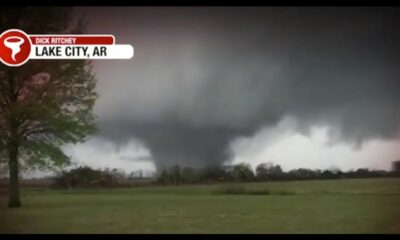News from the South - North Carolina News Feed
Was Helene a 1,000-year storm? Did we have tornadoes in the mountains? • Asheville Watchdog

Today’s round of questions, my smart-aleck replies and the real answers:
Question: There have been various estimates as to the magnitude of the Helene flooding in the French Broad watershed. Some have said it was the 100-year flood. Others have said it was the 500-year flood. The determination is actually fairly straightforward. The calculation can be done for each specific river-gauging station. It is based on the historic record of each year’s highest stage (river level) as recorded at that gauge station. Its accuracy is obviously a function of the length of the record. The longer the record, the greater the statistical soundness of the estimate. The 100-year flood, as you probably know, has nothing to do with 100 years. It is just the flood level that has a 1 percent chance of occurring in any given year. The 500-year flood has a .2 percent chance. The longest gauge record for the Asheville region, based on the U.S. Geological Survey national water data dashboard, appears to be the one on the French Broad River at Asheville. Gauging data are also available on the USGS WaterWatch website. One site says there are discharge data starting in 1985. Another site says the record extends 128 years. Neither site currently appears to be capable of downloading the data set. Can you ask whether anyone has actually determined the nature of the Helene flood at that station? It probably wasn’t the 100-year flood or the 500-year flood, but rather something in-between. A followup question would be how the 2024 flood will cause a reset in the determination of the 100-year flood level for that gauging station.
My answer: I’m going with “one-bazillion-year flood,” mainly because I never want to see another one of these.
Real answer: This is a topic that keeps recurring here, and from what the experts tell me, it certainly seems like a 1,000-year rain event. Whether that translates into a 1,000-year flood event remains a little bit of a gray area.
Nathan Pennington, Buncombe County’s planning director, opened this can of worms at the Nov. 20 daily Helene briefing during a discussion about floodplain management and the National Flood Insurance Program. As Pennington mentioned, the county partners with the state on FEMA flood mapping, with the upshot being the state draws the flood maps for Buncombe.
He showed maps of the Swannanoa area that show the most at-risk section, marked in purple and called the floodway, which are areas that “almost always flood during a rain or storm event.” The next area, in blue, is the 100-year flood area.
“Development is allowed in this area, but standards must be met,” Pennington said, noting that, as the reader said, this means these areas have a 1 percent annual chance of flooding.
Next, in green, was the 500-year flood area, which as Pennington and the reader noted, simply means it has a .2 percent annual chance of flooding.
“What we saw during this event was flood water that so far exceeded the 500-year (flood), it’s very likely we experienced a 1,000-year event, which is not even mapped,” Pennington said.
It’s important to note he said “very likely,” and that he was referring to one area of Swannanoa.
As the reader noted, the U.S. Geological Survey does track river gauge data, so I checked in with public affairs specialist Alexandra Hays to see if it had made a determination, based on the gauge the reader mentioned or any others.
“So, the National Weather Service actually sets the historical designations of ‘100-year-flood, 500-year-flood,’ etc., so to find out how they determine these, you’d have to reach out to them,” Hays said.
More on that in a second.

Like everyone who addresses this topic, Hays also stressed the notion of how “100-year flood” can be misleading. In fact, the USGS has prepared a document on this aptly titled, “The 100-year flood.”
“Hydrologists don’t like to hear a term like ‘100-year flood’ because, scientifically, it is a misinterpretation of terminology that leads to a misconception of what a 100-year flood really is,” the article states, noting that instead hydrologists would say it’s a flood having a 100-year recurrence interval. That’s where the 1 percent chance comes in.
“That being said, we use the term ‘Annual Exceedance Probability’ to track the flooding at individual streamgages, and our teams are still in the process of collecting the needed data to compute the AEPs in areas affected by Helene,” Hays said. “One of our surface water specialists tells me we are going to publish a report of the AEPs for our streamgages in the area for Helene, but it will be a few months before that is available.”
Next, I called up the National Weather Service and spoke to meteorologist Jake Wimberley. Regarding the flood information being given out, Wimberley noted there were “a lot of differing numbers” coming out, because rainfall varies from point to point.
“There were unofficial statements that were really extreme in terms of how rare the event was, so I don’t want to lead you astray,” Wimberley said.
The best source is the National Oceanic and Atmospheric Administration’s data compendium called the Atlas 14 project. That includes analyses that show how much rain would fall at a given point, and how frequently that is expected to recur, which is where the idea of the 100-year event comes from.
Wimberley pulled up data for Asheville Regional Airport, the official recording station for the area.
“So, the airport got 14.19 inches of rain during Helene — the precipitation event that led up to Helene, and the actual passage of the storm,” Wimberley said, noting it was technically listed as a four-day event, although rainfall was very light on that first day.

The 1,000-year measurement for a four-day event would be 11.6 inches.
“So we were over that,” Wimberley said. “And this is for one specific point. I could look at different points and come up with different numbers.”
Indeed, we know rainfall was heavier in certain areas. For instance, Busick in Yancey County recorded 30.78 inches, and Mount Mitchell State Park recorded 24.20 inches, according to a Nov. 7 article on NOAA’s Climate.gov site.
“Estimated rainfall totals from Helene across the southern Appalachians had an Annual Recurrence Interval greater than 1,000 years over a wide area; meaning there is less than a .1 percent chance (annual exceedance probability) of that happening in any given year, according to NOAA’s National Water Center,” the article states.
So that’s indicative of a 1,000-year event.
The North Carolina State Climate office also had an article about Helene that cited the Atlas 14 information, noting that it is “imperfect due to its lack of recent updates.” The office used a three-day measurement of rainfall.
“In Asheville, the three-day total of almost 14 inches goes well beyond the 1-in-1,000 year total for a 72-hour period, which Atlas 14 cites as 11.4 inches,” the article states. “Likewise, the 24.41 inches over three days at Mount Mitchell is off the charts compared to the noted 1-in-1000 year amount of 16.5 inches.”
So, as Wimberley puts it, “The full event in total looks like there were multiple places that it was more than a 1,000-year” rainfall event.
“They haven’t come up with data for more than a one in 1,000-year event,” he added.
Clearly, that much rain translates into a lot of flooding, but it’s tougher to nail down that “1,000-year” designation.
“These major, major rainfall events usually translate to some flooding,” Wimberley said. “But I think it’s more accurate to say this was a 1,000-year rainfall event, as opposed to a 1,000-year flood event.”
Now, as far as Helene causing some kind of “reset” with the data, I contacted David Easterling, director of the National Climate Assessment Technical Support Unit at the National Centers for Environmental Information in Asheville.
“Bottom line is that the National Weather Service is producing a new version of NOAA Atlas 14, which will have both Volume 1 with new values based on the historical observed data, and Volume 2, which will provide estimated values for the future based on climate model projections,” Easterling said.
That means it will include projections related to climate change. Easterling did offer one caveat, though.
“I suspect the Weather Service is far enough along in their data analysis that they may not include Helene, since they expect to release Atlas 15 in 2026,” he said.

Question: We live in Weaverville, in the Reems Creek Golf Community, and we were all incredibly fortunate not to have suffered much in the way of damage to our homes. Our tree-covered streets and homesites, however, lost dozens if not hundreds of trees. While many of them, due to the extensive rainfall before Helene ever hit, were simply toppled from the roots, there were also many that were snapped clean in half at mid-trunk, often with a corkscrew pattern in the wood. This leads us to think that there might have been micro-bursts of mini-tornadoes spawned by the storm. Has there been any official determination to that effect?
My answer: I have micro-bursts of energy these days. It’s the only way I get the Answer Man columns done.\
Real answer: Michael Rehnberg, a National Weather Service meteorologist, said we did not have documented tornadoes in the mountains with Helene. The strongest winds hit around sunrise Sept. 27.
“We had a swath of really strong winds that moved right up the Upstate and then over the state line from South Carolina into North Carolina, and affected a lot of areas in the mountains and the foothills in North Carolina as well,” Rehnberg said. “But those were non-tornadic winds.”

Rehnberg noted that the wind gusts data for Helene has not been certified by the National Centers for Environmental Information, so the numbers are still considered preliminary.
“But all across the Upstate, at least, of South Carolina, and into the southern mountains of North Carolina, there were varying reports of winds over 60 miles an hour,” he said.
That’s clearly strong enough to take down trees, especially with the amount of rain that had fallen over three days, leaving the ground saturated. That can turn root balls into mud, making even large trees vulnerable.
“So when you combine that with higher wind speeds, you can see just kind of the mass devastation — I mean, hundreds, thousands of trees down across these large areas,” Rehnberg said.
The winds were also most devastating on south-facing slopes, as that’s how the storm traveled, from south to north.
A microburst is unlikely to have occurred with this event, Rehnberg said. In a microburst, contracting air aloft descends very suddenly.
“The physics behind that are really closely associated with the way that thunderstorms develop, as opposed to tropical systems,” Rehnberg said. “But that’s not to say that you couldn’t have had very high winds, certainly winds capable of producing the really erratic gusts at the surface.”
Our terrain can play a role with high winds, though, and gusts reaching up into the 60s or maybe higher can cause major, and unusual, tree damage.
“In particular, when you’re dealing with the kind of terrain that you have up in the mountains, what can start out as a simple, straight line wind can simply become very erratic just because it’s responding to all of the rolls and dips in the actual terrain up there,” Rehnberg said.
He would attribute those twisted-looking trees to that phenomenon, he said, not tornadoes.
I’ll note that several sources online, including one academic study, suggest trees will start to break under wind speeds of about 90 mph. But I suspect some other factors could come into play at times, including health of the tree.
Asheville Watchdog is a nonprofit news team producing stories that matter to Asheville and Buncombe County. Got a question? Send it to John Boyle at jboyle@avlwatchdog.org or 828-337-0941. His Answer Man columns appear each Tuesday and Friday. The Watchdog’s reporting is made possible by donations from the community. To show your support for this vital public service go to avlwatchdog.org/support-our-publication/.
Related
The post Was Helene a 1,000-year storm? Did we have tornadoes in the mountains? • Asheville Watchdog appeared first on avlwatchdog.org
News from the South - North Carolina News Feed
Trump says ‘Crimea will stay with Russia’ as he presses for deal to end war in Ukraine

SUMMARY: Trump declared that “Crimea will stay with Russia” while seeking negotiations to end the Ukraine war. His envoy, Steve Wickoff, is headed to Russia to meet President Putin amid escalating violence, including a drone strike that killed three people in Ukraine. Meanwhile, a senior Russian general was killed near Moscow in a bombing, although no one has claimed responsibility. Tensions rise as Ukraine’s President Zelensky refuses to accept the annexation of Crimea, emphasizing that it conflicts with Ukraine’s constitution. Both sides express the desire for peace, but differing views complicate potential compromises and ceasefire efforts.

Trump says ‘Crimea will stay with Russia’ as he presses for deal to end war in Ukraine.
Download the WRAL App: https://www.wral.com/download-wral-apps/5787234/
The Latest Weather: https://www.wral.com/weather/page/1010362/
News Tips:
Online – https://www.wral.com/report-it/
Email – assignmentdesk@wral.com
Subscribe to WRAL:
https://youtube.com/c/wral5
Follow WRAL:
Facebook: https://facebook.com/WRALTV
X: https://twitter.com/WRAL
IG: https://instagram.com/wral
About WRAL-TV:
WRAL is your Raleigh, North Carolina news source. Check out our videos for the latest news in Raleigh, local sports, Raleigh weather, and more at https://WRAL.com
#localnews #northcarolina
News from the South - North Carolina News Feed
Where does Asheville Tourists’ concessions money go? Will local schools be impacted by federal DEI mandates? • Asheville Watchdog

Today’s round of questions, my smart-aleck replies and the real answers:

Question: I want to know if I go to an Asheville Tourists baseball game and pay the full price for a ticket, and buy two beers and two hot dogs, what’s the total cost for that? And how much of that goes to the DeWine organization? How much goes to the city?
My answer: I’m pretty sure most baseball stadium food, including this proposed meal, comes with a personal defibrillator.
Real answer: As we’ve previously reported, the Asheville Tourists Baseball Club is owned by the DeWine Seeds Silver Dollar Baseball LLC, which is owned by the family of Ohio Gov. Mike DeWine. DeWine’s son Brian is the president of the team and the owner-operator with his wife, Kali.
It seems like whenever Gov. DeWine, a Republican, makes some news in Ohio, I get some questions about the local team here and where the money goes. As we reported in 2022, the governor “personally owns 32 percent of the team, according to records, but has no management role in the team.” Brian DeWine, a resident of Asheville since 2010, calls the Tourists ‘a local, family-owned business.’”
Now, about those dogs and brews. First, Brian DeWine tried to upsell the fan.

“Are you sure your reader doesn’t also want to wash that down with a deep-fried moon-pie? Or a churro sundae?” DeWine asked.
Tempting, but I think they were hoping to live at least until Sunday.
“A beer is going to be $8-$9 and $1 and $3 on Thirsty Thursday,” DeWine said. “Hotdogs are $3.75, except on Fridays when they are $1.”
Tickets start at $9.50 for kids, $10.50 for military and seniors and $11.50 for an adult, he added, noting that all prices include sales tax. So under normal conditions, it looks like you’d be dropping $35 to get in, scarf down two ‘dogs and two beers, and enjoy the game.
The Tourists run the complete food and beverage operation, so the city, which owns McCormick Field, does not reap any financial benefits from it.
“The city does not collect a portion of food and beverage sales during baseball games at McCormick; we do however collect an annual rent payment from the team,” Chris Corl, the city of Asheville’s director of community and regional entertainment facilities, said via email. “This year’s rent is lower than ‘normal’ due to disruptions related to the construction project.”
The 2025 season at McCormick Field is being played “under construction,” as DeWine previously told The Watchdog. Some areas of the ballpark will be closed to fans during certain parts of the season, as the stadium undergoes a $38.5 million renovation project to comply with dictates from Major League Baseball to upgrade locker rooms and other facilities.
Corl provided the city’s rental rates for McCormick Field for last year, this year and next year:
- 2024: $100,000
- 2025: $50,000
- 2026: $450,000
The Tourists had their home opener April 8, although it was a rainy affair. The team’s 132-game schedule this year features 66 home games, including matchups on July 4, Mother’s Day, Memorial Day Weekend, and Labor Day Weekend.

Question: I haven’t heard any communications from the Asheville City Schools superintendent or the Buncombe County Schools district on how they are handling the Trump administration’s attack on DEI (diversity, equity and inclusion). I know that the ACS central office does have a fulltime staff member committed to equity, but I have not heard anything about changes in its programming or staffing. Might make for an interesting article to reach out to the Districts to ask what they are doing to respond to Trump’s and the Department of Education’s blocking of funding for districts with DEI policies or programs.
My answer: They’re keeping mum? Really? That’s odd in this climate …
Real answer: Asheville City Schools Chief of Staff Kimberly Dechant answered on behalf of city schools.
“At this time, Asheville City Schools remains committed to its mission of fostering an inclusive and equitable environment for ALL students and staff,” Dechant said via email (emphasis on “ALL” was hers). “There have been no changes to our programming or staffing related to Diversity, Equity, and Inclusion.”
On April 3, the Trump administration’s Department of Education sent a “reminder” notice to school systems titled, “Reminder of Legal Obligations Undertaken in Exchange for Receiving Federal Financial Assistance and Request for Certification under Title VI and SFFA v. Harvard.”
The court reference refers to the 2023 U.S. Supreme Court ruling in Students for Fair Admissions v. Harvard University and UNC Chapel Hill, which essentially banned consideration of race in college admissions.
The reminder notice sent to schools further states: “Title VI of the Civil Rights Act of 1964 provides that ‘no person in the United States shall, on the ground of race, color, or national origin, be excluded from participation in, be denied the benefits of, or be subjected to discrimination under any program or activity receiving federal financial assistance.”
As NPR reported last week, in its latest DEI directive to K-12 school leaders, “the Trump administration has asked every state and local school leader to recommit to Title VI of the Civil Rights Act, which prevents race-based discrimination for federally funded programs. It says states that fail to recertify could lose their federal funds, including grants intended for low-income students.”
(On Thursday, a federal judge ruled that the Trump’s administration had overstepped the executive branch’s legal authority over local schools and had not provided a sufficient definition of DEI.)
Dechant said ACS is “closely monitoring developments at both the federal and state levels regarding any potential legislation or policy changes that may impact DEI initiatives.
“Until such legislation is passed and its implications are clarified, we will maintain our current approach and continue to prioritize equity in education for ALL students,” Dechant said, again emphasising “all.”
At Buncombe County Schools, spokesperson Ken Ulmer said the system “continues to comply with all federal, state, and local laws.
“Buncombe County Schools does not have any dedicated positions such as diversity officers,” Ulmer said. “As a school system, BCS is committed to serving each and every student in our district with the respect, support, and opportunities they deserve.”
The county system does have Assistant Superintendent Jamie Johnson’s role listed on its website as “Educational Equity and Student Support.”
Asheville Watchdog welcomes thoughtful reader comments on this story, which has been republished on our Facebook page. Please submit your comments there.\
Asheville Watchdog is a nonprofit news team producing stories that matter to Asheville and Buncombe County. Got a question? Send it to John Boyle at jboyle@avlwatchdog.org or 828-337-0941. His Answer Man columns appear each Tuesday and Friday. The Watchdog’s reporting is made possible by donations from the community. To show your support for this vital public service go to avlwatchdog.org/support-our-publication/.
Related
The post Where does Asheville Tourists’ concessions money go? Will local schools be impacted by federal DEI mandates? • Asheville Watchdog appeared first on avlwatchdog.org
News from the South - North Carolina News Feed
Lesson learned: How the pandemic provided a teachable moment for NC lawmakers in latest Helene relief bill

There’s going to be a full house in Ashe County’s public schools this summer. After a mix of bad weather and severe storms closed schools there for 47 days, Superintendent Eisa Cox plans to take full advantage of a Helene learning loss summer school program. It’s funded by the legislature in its most recent recovery bill.
The $9 million School Extension Learning Recovery Program is open to schools in 13 impacted Western North Carolina counties: Ashe, Avery, Buncombe, Burke, Haywood, Henderson, Madison, McDowell, Mitchell, Rutherford, Transylvania, Watauga and Yancey.
It covers grades 4 through 8 and focuses on intensive recovery in math and reading. Each participating school will receive at least $20,000 for the program and possibly double that, depending on how much state money is left over after all schools get initial funding.
While one of the lower-dollar items in the $524 million recovery package, the summer school program could mean a lot for Ashe County students. The school system already uses grant funding to run summer programs for various grades. Still, without state funds, having a “robust” learning loss program serving multiple grades in different schools would have been impossible, Cox said.
“That’s a hefty price in order to be able to do that for kids,” she said. “You’re talking about feeding them, transportation, the cost of the teacher over the summer, and, of course, you don’t want to put 30 kids in a class. That’s not going to achieve what you want for students who are already struggling to be on grade level.”
Helene learning loss overlooked — at first
While Gov. Josh Stein’s Helene recovery request included a summer learning loss program, the first version of the General Assembly’s Helene recovery bill didn’t offer a penny for public schools.
State Rep. Marcia Morey, D-Durham, took note. She recalled a retreat where she spoke with public school leaders from Western North Carolina who told her how “dire” the need was to get back in the classroom. Four years out, students were still recovering from pandemic learning loss. Helene only exacerbated the issue.
“We have eight counties. We have at least four schools (where) kids couldn’t go back — they had to go to other facilities,” she said in February on the House floor. “We have two schools totally decimated. And so we’re not doing it today, but our public school kids need a place to go. They need a facility. I hope in the next bill we will address the children out west in these affected counties.”
Morey tried to file an amendment to the legislature’s initial bill, but was told she was too late.
The next version of the bill included a $9 million summer learning program.
Morey said she wasn’t directly involved.
“I think they just knew they had to respond to it,” she told Carolina Public Press. “It was astounding that nothing was included in the first relief bill.”
Lessons from the pandemic
Not all missed school days are created equal. Losing one day could take a few hours, a day or a week to recover, depending on the grade level and subject matter.
For example, earlier grades typically learn a “mile wide” and an “inch deep,” covering a broader range of subjects than later grades, which tend to focus on one or two concepts, explained Jeni Corn, the impact evaluation and strategy director for the North Carolina Collaboratory.
This can make it harder for younger students to make up for lost time. Additionally, math concepts typically take longer to recover than those involving social studies.
The legislature first partnered with the North Carolina Collaboratory, housed at UNC-Chapel Hill, to research the impacts of the pandemic on K-12 education. Among the various studies was one looking at the effect of a state-funded summer school program designed to address pandemic learning loss.

That study now forms the basis of the Helene summer school program, Corn said.
Researchers found that higher summer school attendance correlated with better attendance the following academic year for students in grades 4 through 8 and seventh and eighth graders. They also discovered modest gains in math test scores among students who had high summer attendance, but no impact on reading scores.
Summer school programs can’t cure all learning loss, but they can improve student engagement through continued connection with their fellow peers and teachers, the researchers concluded.
Cox, the Ashe County superintendent, came to the same determination. A dozen days of summer school is never going to be enough time to recover from weeks of learning loss, but it can still help.
“When kids aren’t in school, they may not have a meal,” Cox said. “When kids are not in school, they may not have an adult around them during most of the day that can help them provide the structure to be able to read to them, to be able to provide them with direction.”
This article first appeared on Carolina Public Press and is republished here under a Creative Commons Attribution-NoDerivatives 4.0 International License.![]()
The post Lesson learned: How the pandemic provided a teachable moment for NC lawmakers in latest Helene relief bill appeared first on carolinapublicpress.org
Note: The following A.I. based commentary is not part of the original article, reproduced above, but is offered in the hopes that it will promote greater media literacy and critical thinking, by making any potential bias more visible to the reader –Staff Editor.
Political Bias Rating: Center-Left
The content presents information regarding a summer learning program in Western North Carolina aimed at addressing the educational impact of the pandemic, specifically referring to "Helene learning loss." The mention of lawmakers and educators collaborating to implement a state-supported program suggests a mildly progressive viewpoint, as it emphasizes government involvement in addressing educational challenges. Additionally, the sourcing from Carolina Public Press, described as an "independent newsroom" committed to uncovering overlooked issues, aligns with narratives often found in Center-Left media that advocate for social responsibility and public welfare initiatives. Overall, while the content is informative and not overtly biased, the context indicates a leaning towards Center-Left perspectives related to governance and education policy.
-

 News from the South - Florida News Feed5 days ago
News from the South - Florida News Feed5 days agoJim talks with Rep. Robert Andrade about his investigation into the Hope Florida Foundation
-

 News from the South - Alabama News Feed7 days ago
News from the South - Alabama News Feed7 days agoOp-Ed: Colleges shouldn’t need remedial algebra classes: Five K-8 policy solutions to address math proficiency | Maryland
-

 News from the South - Arkansas News Feed6 days ago
News from the South - Arkansas News Feed6 days agoValerie Storm Tracker
-

 News from the South - Virginia News Feed6 days ago
News from the South - Virginia News Feed6 days agoHighs in the upper 80s Saturday, backdoor cold front will cool us down a bit on Easter Sunday
-

 News from the South - Kentucky News Feed6 days ago
News from the South - Kentucky News Feed6 days agoU.S. Supreme Court pauses deportations under wartime law
-

 News from the South - Kentucky News Feed7 days ago
News from the South - Kentucky News Feed7 days agoTrump administration revokes Murray State international student’s visa
-

 News from the South - Texas News Feed7 days ago
News from the South - Texas News Feed7 days agoCourt restores status of 3 international students in Texas
-

 Local News7 days ago
Local News7 days agoEaster events happening across the coast









































